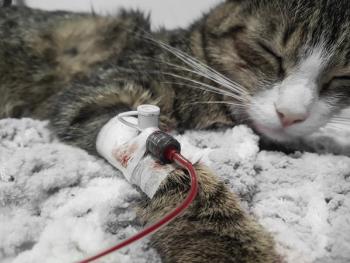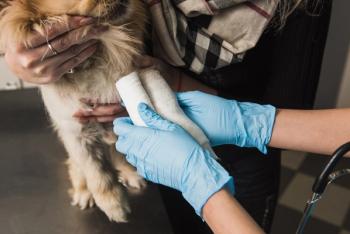
What to do when a patient wont survive transfer
Addressing critical issues first, such as hemorrhage, shock and electrolyte abnormalities, can greatly improve the likelihood of survival after transfer to emergency care.
Alyona/Stock.adobe.com
As staff criticalist at Cornell University Veterinary Specialists, Elisa Mazzaferro, MS, DVM, PhD, DACVECC, is no stranger to receiving severely ill or injured patients. At
“It's always better for the patient to stabilize them before transferring them to an emergency facility for care because you can't predict if there will be an accident on the road that may slow them down,” Dr. Mazzaferro says.
She explained that critical patients often require stabilization before they can be transferred safely to an emergency facility for 24-hour care. Even a seemingly stable patient can destabilize quickly, which is why prioritizing certain diagnostic and management steps can provide valuable information on patient status and lead to a positive income.
Start with the ABCs
The ABCs of cardiopulmonary evaluation (i.e. airway, breathing, and circulation) should always be prioritized for incoming critical patients. Respiration rate and character, which can be evaluated quickly from a distance, may suggest the presence of certain trauma- or disease-related conditions, such as rib fracture, flail chest, pulmonary contusion or diaphragmatic hernia.
Thoracic focused assessment using sonography for trauma/triage (TFAST) can help identify critical cardiopulmonary problems, such as pneumothorax or pleural or pericardial effusion. TFAST is particularly useful for patients that are too unstable for restraint, as the procedure can be performed with the patient standing or in sternal recumbency. Thoracentesis may be another useful tool both for diagnosis and treatment of certain respiratory problems, such as pneumothorax.
Airway obstruction
Long, deep respirations with high-pitched inspiratory stridor are characteristic signs of laryngeal paralysis/collapse or tracheal collapse. Respiratory difficulty on inspiration suggests tracheal collapse within the cervical region, whereas intrathoracic tracheal collapse typically causes respiratory difficulty during exhalation. Patients in respiratory distress may calm sufficiently after administration of small amounts of butorphanol and acepromazine. If these medications are ineffective, however, intubation and oxygen therapy are indicated until the patient can be transferred.
Shock and fluid therapy
Trauma-related internal or external hemorrhage can easily lead to hypovolemia and shock. Treatment should focus on slowing hemorrhage and restoring blood volume, while taking care not to exacerbate blood loss through fluid overload. Equipment such as compression bandages, ligature materials, and tourniquets should be readily accessible to manage significant hemorrhage.
IV catheter placement may be complicated for small/exotic patients or those with peripheral edema, dehydration, or hypotension. In such cases, either surgical cutdown to a vessel or placement of an intraosseous (IO) catheter may be necessary. Dr. Mazzaferro noted that uptake of fluid and other products is similar through IO and IV routes and that IO catheters are well tolerated by most patients.
Hypovolemic shock is typically addressed with isotonic crystalloids and natural and synthetic colloids. The patient's status should be assessed closely and continuously to ensure that acceptable heart rate, blood pressure, capillary refill time, and mucous membrane color are restored and maintained. However, blood pressure should be measured regularly to avoid fluid overload.
Dr. Mazzaferro acknowledged that fluid therapy can worsen pulmonary edema and dilutional coagulopathies; however, a bolus with a synthetic colloid and hypertonic saline can also help stabilize the hypovolemic patient. By drawing fluid from interstitial and intracellular spaces into the circulation, bolus therapy can significantly improve circulating fluid volume and oxygen delivery.
Hyperkalemia
Patients with postrenal obstruction, uroabdomen or hypoadrenocorticism may experience life-threatening electrolyte abnormalities. Hyperkalemia can cause severe bradycardia or asystole and must be addressed before sedation, anesthesia or travel is attempted. Dr. Mazzaferro mentioned several treatment options for hyperkalemia, such as methods to drive potassium into the cell (e.g. IV insulin/dextrose or sodium bicarbonate) or those with a cardioprotective effect (e.g. calcium gluconate). If immediate transfer is not available for a patient with uroabdomen, Dr. Mazzaferro recommended placing a drainage catheter into the abdominal cavity under local anesthesia. Once connected to a closed collection system, the catheter can remove urine from the abdomen until the source of urinary trauma can be repaired.
Pericardial effusion
Pericardial effusion can adversely affect cardiac output, blood pressure and tissue perfusion. For unstable patients with pericardial effusion, such as the geriatric pet with a cardiac neoplasm, Dr. Mazzaferro recommended performing pericardiocentesis before transfer is attempted. If possible, an echocardiogram should be performed first to scan for a right atrial, right auricular or heart base mass, and electrocardiography leads should be in place during the procedure to monitor for cardiac dysrhythmias. Place a small amount of the obtained fluid into a red-topped tube to observe for clots. “If the fluid clots, it's a sign of an active bleed,” Dr. Mazzaferro notes. Because pericardial effusion can return quickly, these patients should be monitored closely. Because pericardial effusion can return quickly, these patients should be monitored closely.
Blood loss, anemia and transfusion
According to Dr. Mazzaferro, the underlying cause of anemia (blood loss, destruction, or lack of production) provides clues as to whether hemoglobinemia or hypovolemia is the patient's major issue. Depending on the cause, fluid therapy or a blood product transfusion may be indicated before the patient is transferred.
A combination of IV crystalloids, colloids and blood products can provide hemodynamic stabilization for patients experiencing severe anemia or hemorrhage. When considering a blood transfusion, Dr. Mazzaferro reminded the audience that dogs have six possible blood groups, yet they lack naturally occurring alloantibodies against other blood types. Therefore, a single transfusion can be administered without first performing blood typing or a cross-match. In contrast, cats have three primary blood types and naturally occurring antibodies and, therefore, must undergo blood typing or cross-match before blood transfusion to avoid an adverse reaction. If neither is possible, Dr. Mazzaferro advised veterinarians to administer a crystalloid fluid bolus to increase circulating intravascular fluid volume. Then, contact the emergency facility to confirm that type A and B blood products are on hand before the patient is referred.
A single xenotransfusion (i.e. canine blood transfer to a feline recipient) can be a life-saving option for the critically anemic cat. However, xenotransfused erythrocytes live only 3.6 days, and cats will develop antibodies against canine blood within 7 days after the transfusion. Therefore, Dr. Mazzaferro stated that xenotransfusion should be reserved for cases in which no other options are available.
“However, I would rather give a cat canine blood to get it through and get it to a facility that has the cat's type-specific blood, then potentially give it the wrong feline blood type and potentially kill it,” Dr. Mazzaferro says.
Veterinary ambulance services
If possible, pet owners should not transport critical patients to a referral facility alone. Instead, Dr. Mazzaferro explained that the referring veterinarian, a technician and a driver can ensure constant care throughout the transfer. Before moving the patient, call the referral facility to communicate your estimated time of arrival. Provide copies of medical records, including diagnostic test results and updated treatments, to the facility.
“It's also very important that everyone involved in the transport has each other's contact information: the pet owner, the referring hospital and the destination hospital,” Dr. Mazzaferro says. “That way if the pet owner, or whomever is transporting the pet, gets lost, time is not wasted driving in circles, which has happened before.”
Veterinary ambulance services, although potentially expensive, offer another option for the transfer of critical and unstable patients. Dr. Mazzaferro emphasized that the high level of care provided by these services can increase the likelihood of patient survival. Also, using a dedicated service relieves the referring veterinarian and staff of the responsibility (and potential liability) of transfer.
Dr. Natalie Stilwell provides freelance medical writing and aquatic veterinary consulting services through her business, Seastar Communications and Consulting. In addition to her DVM obtained from Auburn University, she holds a MS in fisheries and aquatic sciences and a PhD in veterinary medical sciences from the University of Florida.
Newsletter
From exam room tips to practice management insights, get trusted veterinary news delivered straight to your inbox—subscribe to dvm360.




